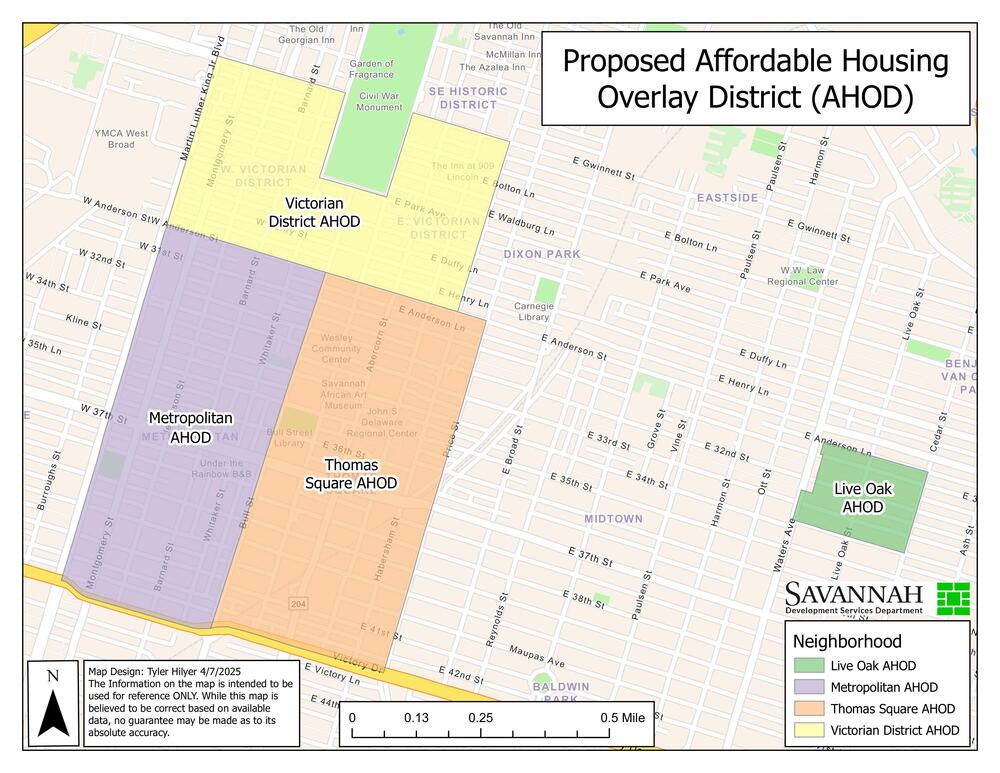
Caption
The boundaries of Savannah's inaugural four affordable housing overlay district zones, as proposed by city staff and approved by councilmembers.
Credit: City of Savannah
LISTEN: More than 400 acres south of downtown will see their zoning restrictions relaxed, potentially opening the door to more affordable housing options for struggling renters and hopeful homebuyers. GPB's Benjamin Payne reports.

The boundaries of Savannah's inaugural four affordable housing overlay district zones, as proposed by city staff and approved by councilmembers.
Savannah City Council voted Thursday to approve the boundaries of a new affordable housing overlay district aimed at easing the city's mounting housing crisis by enabling higher-density development in select neighborhoods near the city center.
The roughly 440-acre overlay spans much of the Thomas Square and Metropolitan neighborhoods — areas sometimes collectively referred to as the Starland District — and includes parts of the Victorian District directly adjecent to Forsyth Park, as well as a smaller 22-acre section of the Live Oak neighborhood further east.
The measure loosens density restrictions in Savannah's traditionally single-family neighborhoods, allowing for developments such as duplexes and apartment buildings — so long as the new units qualify as affordable, defined by the city as costing no more than 30% of a household's gross income.
Supporters say the overlay is a step toward solving a worsening affordability gap in Savannah, where nearly half of renters are considered by the city to be "cost-burdened," meaning that they spend more than 30% of their gross income on housing.
"Every single one of us have heard that Savannah is becoming too expensive in which to live," said Mayor Van Johnson, who spoke in favor of the measure. "This is one of the ways we address it. Either we do the things that help us to achieve affordability or we allow unaffordability to continue to persist."
The overlay creates a "density bonus" program, allowing developers to apply for exceptions such as reduced lot sizes and setback requirements, but only if the project includes covenanted affordable housing units.
Councilmembers passed a related zoning text amendment last month to establish the overlay district's regulatory framework, but Thursday's vote marked the first application of that framework to specific neighborhoods.
Alderwoman Estella Edwards-Shabazz said the overlay is a long-overdue move to spur development that's actually within reach for working families.
"We have got to get started with increasing our inventory for housing," she said. "This is real in this city. It's real all over this country. So, we're gonna do something. This is a council that 'do something' and make things happen, and we're going to continue that."
Public testimony at Thursday's meeting was overwhelmingly in favor of the plan, with several residents urging councilmembers to pass the measure for the sake of younger and lower-income Savannahians.
"My generation knows that none of us will be able to buy our own houses any time soon, if ever," said Tigerlily Harrington, 24, a resident of the Victorian District. "For many of my peers, affordable rent is also out of reach, and they instead live with their parents or in uncomfortable or unsafe living conditions."
Harrington also pointed out the high walkability and transit access in the affected neighborhoods, calling the amendment "an opportunity for this council to put your promises into action" by working toward affordability for "the people who keep this city running, who make this city the beautiful, desirable place that it is."
Historic Savannah Foundation preservation director Ellie Isaacs praised the overlay as striking a balance between affordability and historic character, saying the change will "allow for the development of much-needed housing options, while providing flexibility and zoning to ensure that new development respects the context and character of existing structures."
The ordinance allows City Council to expand the overlay in the future to additional neighborhoods that wish to participate, a provision city officials say they hope will encourage broader buy-in over time.
Johnson framed the measure as a defense against the rising tide of corporate landlords and property speculation: "Our city continues — like other cities — to be besieged by equity firms and people who are just buying up property. … What we're trying to do is really trying to maintain Savannah for Savannahians."